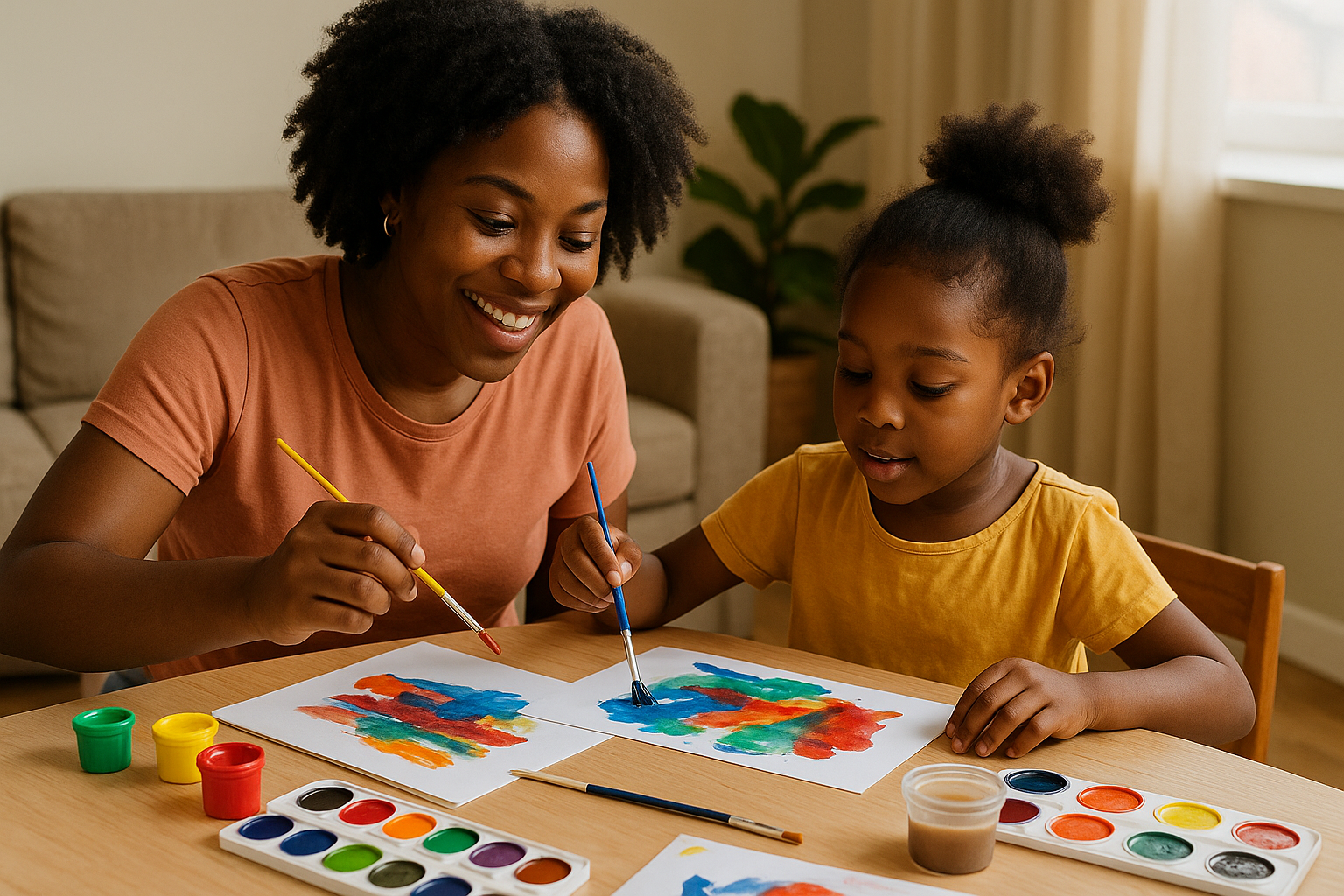Painting isn’t just a fun pastime — it’s one of the most effective tools for early childhood development. When children dip their fingers into bright colors or glide a brush across a page, they’re doing more than creating art. They’re enhancing motor skills, exploring emotions, developing sensory awareness, and learning to express themselves without words.
This article will guide you through fun, practical, and mess-friendly painting activities you can easily set up at home. Each one supports your child’s cognitive and sensory development while fostering creativity and independence.
Why Painting Matters in Early Learning
Painting offers a multi-sensory experience, activating multiple areas of the brain. Through painting, children:
- Strengthen fine motor skills
- Learn color recognition and mixing
- Boost hand-eye coordination
- Explore textures and materials
- Express thoughts and emotions
- Build patience and focus
Most importantly, it creates a space for joy and self-discovery.
Setting Up a Painting Space at Home
Before diving into the activities, create an inviting and safe environment for painting:
- Choose a washable surface (e.g., a plastic table cover or tray)
- Use washable paints specifically designed for kids
- Have aprons or old T-shirts to protect clothes
- Keep wet wipes and towels close for quick cleanup
Involve your child in setting up the materials. This builds anticipation and helps teach responsibility.
1. Finger Painting Fun
Best for: Toddlers and preschoolers
Materials: Non-toxic finger paint, thick paper, smocks
Let your child explore painting with just their fingers. Encourage them to swirl, press, and slide their hands across the page.
What they learn:
- Sensory exploration (temperature, texture)
- Cause and effect (“When I press harder, more paint spreads”)
- Independence and creativity
Tip: Add flour to the paint to thicken it for toddlers who enjoy more tactile feedback.
2. Q-Tip Pointillism
Best for: Fine motor development
Materials: Q-tips, watercolor or acrylic paint, paper
Teach your child to dab Q-tips in paint to make dot patterns or pictures. This technique is inspired by the art of pointillism and enhances focus and control.
Learning focus:
- Precision and coordination
- Pattern recognition
- Calm, repetitive motion to soothe hyperactive energy
3. Nature Brush Painting
Best for: Outdoor learning integration
Materials: Leaves, twigs, pine needles, feathers, paint, paper
Instead of regular brushes, let your child use natural objects to paint. Each item produces a unique texture.
What it teaches:
- Observation of nature’s textures
- Experimentation and curiosity
- Understanding of tool impact (a leaf creates a different stroke than a twig)
4. Texture Painting with Household Items
Best for: Sensory awareness
Materials: Bubble wrap, sponges, string, cardboard pieces
Have your child dip various items into paint and stamp or drag them across paper.
Development benefits:
- Texture exploration through sight and touch
- Understanding material properties
- Cause-effect reasoning (“This sponge leaves holes!”)
5. Ice Cube Painting
Best for: Hot days and sensory stimulation
Materials: Ice cube tray, water, food coloring, craft sticks
Freeze colored water with a stick in each cube. Once frozen, let your child paint on thick paper as the ice melts.
Why kids love it:
- Cool sensation on fingers
- Watching color trails melt and blend
- Learning about temperature, color mixing, and water states
6. Blow Painting with Straws
Best for: Lung strength and visual creativity
Materials: Watered-down paint, paper, straws
Place drops of paint on paper and have your child blow through a straw to move the paint into wild shapes.
Bonus learning:
- Directional control
- Observation of flow and blending
- Abstract thinking and imagination
7. Symmetry Painting (Fold-and-Press)
Best for: Early math and visual symmetry concepts
Materials: Paper, tempera paint
Let your child place blobs of paint on one side of a folded paper, then press the two sides together. Open it to reveal a symmetrical image.
Learning elements:
- Bilateral coordination
- Patterns and symmetry
- Surprise and delight
8. Paint-to-Music Session
Best for: Emotional expression
Materials: Paint, music playlist, paper
Play different types of music (classical, upbeat, calming) and ask your child to paint what they feel while listening.
Skills developed:
- Emotional intelligence
- Rhythm and tempo through brush strokes
- Sensory-emotional link recognition
9. Story-Based Painting
Best for: Language and comprehension
Materials: Favorite storybook, paint, brushes
Read a book together and then ask your child to paint their favorite part of the story. Let them explain their painting afterward.
Bonus learning:
- Narrative recall
- Visualization
- Communication through art
10. Salt and Watercolor Experiment
Best for: Science meets art
Materials: Watercolors, salt, thick paper
Have your child paint with watercolors, then sprinkle salt on the wet paint. Watch crystals form and change the patterns as the painting dries.
What they discover:
- Absorption and crystallization
- Artistic cause and effect
- Texture creation using chemistry
Encouraging Creativity Without Pressure
Let children:
- Choose their colors
- Paint freely, even if it’s abstract
- Decide when they’re done
- Describe their artwork in their own words
Avoid asking “What is it?” Instead, say: “Tell me about your painting.” This approach builds confidence and reinforces that their choices are valued.
Tips for Managing Mess Without Stress
- Use a baking tray to contain small projects
- Keep painting near the kitchen or bathroom for easy cleanup
- Limit paint amounts to avoid spills
- Set a timer for clean-up songs or routines
Display Their Art
Showing that you value their work builds pride and motivation. Try:
- Hanging paintings with clothespins and string
- Creating a rotating gallery on the fridge
- Saving favorites in a “My Art Book” folder
Painting Is More Than Art — It’s Development
From sensory stimulation to emotional expression and cognitive growth, painting is one of the most holistic learning tools you can use at home. With a few basic supplies and an open attitude, you’ll open up a world of colorful discovery for your child — one brushstroke at a time.
